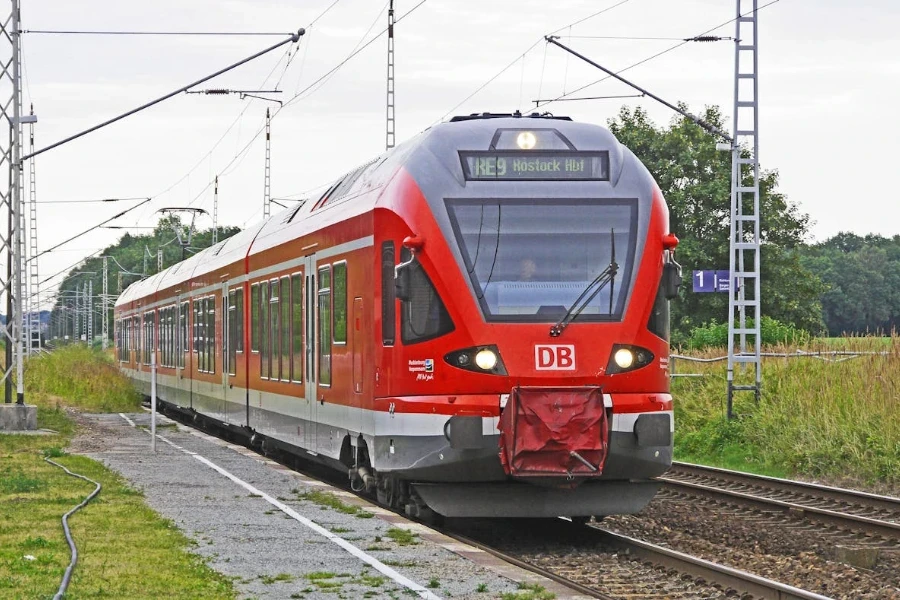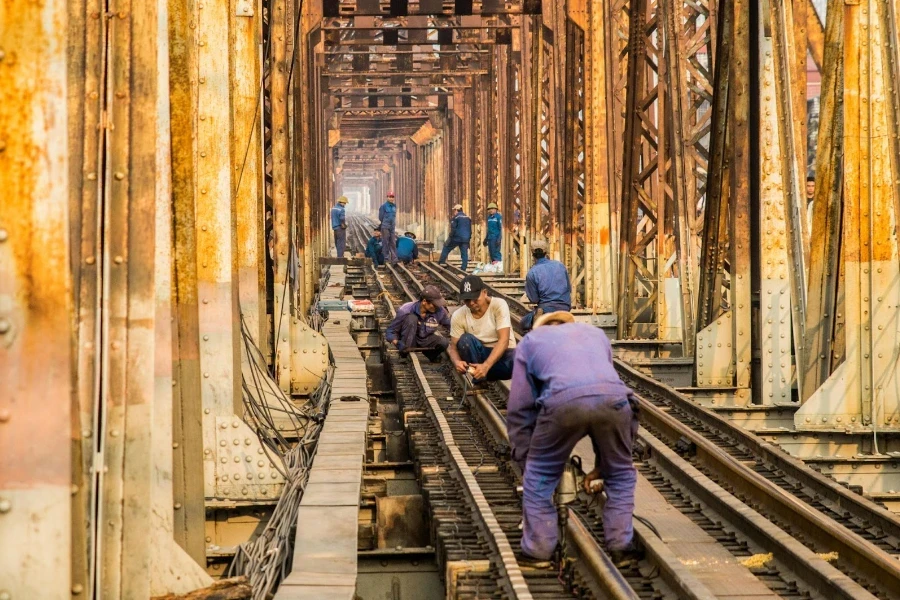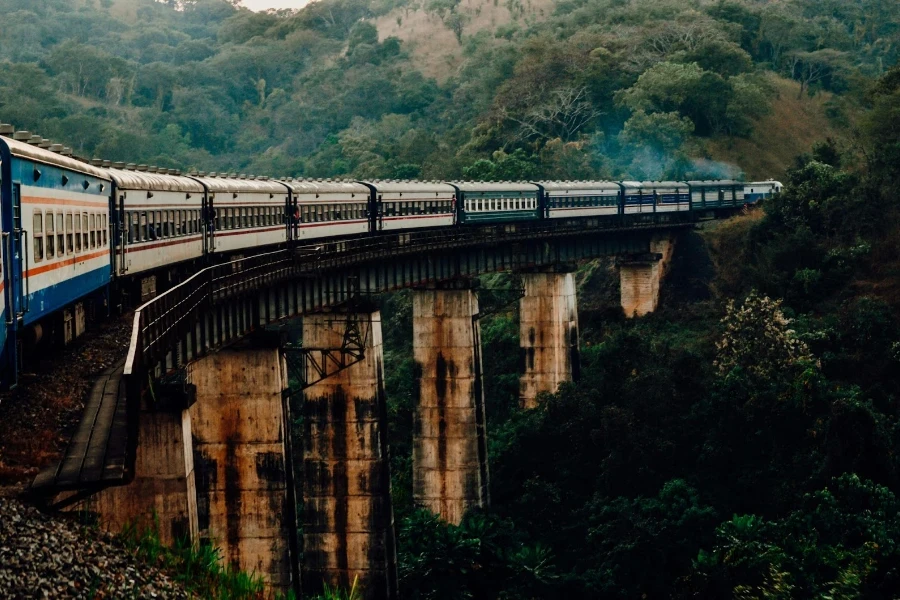The adage ‘unity is strength’ is vividly demonstrated in railway freight transportation. This is obvious as a single freight train, equipped with numerous carriages, is capable of transporting an equivalent load as that of dozens or even hundreds of trucks.
However, despite its many advantages, rail freight transportation faces increasing challenges. Continue reading to discover the usefulness and practicality of railway freight, the challenges it encounters, and the solutions to address them.
Table of Contents
Advantages of railway transportation
Challenges of railway transportation
Practical solutions to railway challenges
Clear tracks ahead
Advantages of railway transportation
Efficiency and reliability
The railway system has long been trusted as a cornerstone of freight movement, with the earliest documented use dating back to 2200 BC in the Babylonian era, where carts were maneuvered along tracks by horses or humans. To date, its efficiency and reliability are not simply a ‘track record’ in the figurative sense but a literal testament to the enduring power and reliability of rail transport, echoing through the ages.
The cost-effectiveness of railway transportation, particularly its prowess in moving large volumes of cargo at competitive rates with consistent, fixed schedules, highlights its efficiency. It is especially notable for its reliability, establishing itself as an indispensable element of the supply chain in times of crisis or operational disruption—a key observation well-recognized by industry experts.
The most recent situation reflecting the reliability is the logistical challenges in the Red Sea route. This situation has resulted in an inevitable reroute from the ocean to the rail system for cargo between China and the EU, as this Red Sea shipping crisis affects cargo movement between the two regions.
The rail route emerges as a much faster, safer, more cost-effective, and resilient alternative compared to conventional sea routes during such tumultuous periods. This incident underscores the rail system’s capacity to serve as a reliable backup, ensuring continuity in logistics operations under unforeseen circumstances.
Sustainability

Railway transportation shines as a leading example of eco-friendliness within the logistics and freight movement industry. This mode of transport is not only notable for its minimized wear and tear on vehicles and extended maintenance cycles but also for its significant reduction in pollutants and fuel consumption. The strategic employment of trains ensures the longevity of transportation assets and indirectly bolsters the environmental sustainability of operations, positioning rail as a leading green choice for goods movement.
The progress of electric rail systems highlights the route toward ecological sustainability even further. A significant portion of the world’s railway infrastructure is already electrified, particularly in the Asia Pacific region—50% in Australia, 72% in China, 80% in Japan, 85% in India, and over 60% in Europe. This worldwide trend towards electric power showcases dedication to cutting carbon emissions and reducing reliance on fossil fuels.
While the efficiency of electric locomotives can vary based on their type and condition, generally, electric locomotives share numerous efficiency benefits with electric vehicles. This includes higher energy conversion efficiency, minimized energy loss to heat, and reduced energy requirements for auxiliary components.
Hence, the shift to electricity, sourced from the grid and increasingly derived from renewable energy, significantly boosts the efficiency of rail transport. Electric locomotives exhibit exceptional well-to-wheel efficiency, outperforming diesel engines. When fueled by renewable sources, such as wind or solar, the overall environmental impact is further lessened, consuming even less energy and producing no direct emissions like fossil fuels.
Safety
The safety of railway transportation manifests in two distinct ways: through comparison with road transportation and through the security features and measures specific to railways themselves. For instance, compared to the hazards present in road transportation, the likelihood of encountering an accident on the railway is substantially lower, reportedly around 40 times less—a fact that highlights the superior safety railways offer.
The safety and integrity of railway freight services are further ensured through the implementation of robust security protocols in railway infrastructure. Considering the reality that a significant portion of the world’s railway networks is either nationalized or operates under a mix of nationalized systems with private operators, the prevalence of nationalized systems in large and strategically important rail networks typically often implies enhanced security measures, reflecting strong governmental involvement.
This includes the deployment of comprehensive surveillance systems, like Closed-Circuit Television (CCTV) cameras, that oversee station premises and detect any unusual or illicit activities. Moreover, the application of sophisticated access control mechanisms restricts entry to sensitive or exclusive zones, strengthening the security framework.
These security enhancements not only protect valuable cargo from theft and damage, ensuring its safe transit but also support freight safeguarding against potential loss and enable cargo status tracking. Furthermore, through vigilant monitoring and these security measures, repair costs and accident risks are minimized, leading to smoother operations and reduced chances of delays and disruptions.
Seamless transportation network

The seamless network of railway transportation is clearly reflected in its extensive connectivity and accessibility to diverse regions and destinations, offering flexibility and convenience to shippers, and facilitating smooth goods movement over long distances. This uninterrupted flow is essential for supply chain efficiency and timeliness, with common delays in other modes like road and air, being relatively rare in railway transport due to its planned streamlined schedules.
The move toward automated and computerized operations in the railway systems of various countries further enhances the uninterrupted connections of railway transport services by reducing terminal station dwell times and lowering document handling costs.
Meanwhile, the fluid transition between rail and other transportation modes also exemplifies a significant advantage of railway transport. This is particularly evident in the use of standardized containers and trailers that facilitate intermodal transport between road and rail, eliminating the need for labor-intensive unloading and reloading. These cargo holders are seamlessly transferred between modes, with similar efficiencies in transitions from rail to ship, assuming adequate port facilities.
Challenges of railway transportation
Capacity limitation and alleviating congestion
The well-organized schedule nature of railway transportation, in fact, makes it relatively less prone to capacity and congestion issues, particularly regarding less time-sensitive freight arrangements. Nonetheless, it’s worth highlighting that there are indeed inherent limitations of rail freight’s capacity compared to sea freight. For instance, the capacity of a standard freight train stated to be around 100 TEU, starkly contrasts with that of a cargo ship.
Such capacity constraints become even more pronounced during peak demand periods. Regardless of meticulous scheduling, a significant surge during peak seasons can intensify the potential shortage of trains, tracks, or terminals. The capability of railway freight to fulfill the current and future demands and expectations of shippers is restricted in this context, as its capacity is tightly linked to infrastructure readiness and locomotive vehicle availability.
The capacity limitation and issue of congestion can further affect the performance and competitiveness of railway transportation in times of crisis and crisis management. For example, congestion or capacity limitations due to the sudden emergence or worsening of new and ongoing wars in different regions can exacerbate the railway system’s challenges in logistical disruptions even more acutely.
Infrastructure development and financial investment

Central to the enhancement of railway transportation capacity is the need for infrastructure upgrades. This requires not only substantial financial investments but also intricate strategic planning. Essential for the efficient movement of trains, railway transportation requires a comprehensive set of infrastructure, including tracks, tunnels, stations, and terminals. Aside from mere expansion, the continuous maintenance and improvement of existing infrastructure, as well as the development and augmentation of new facilities, are critical components of such a requirement too.
Yet all these necessary upgrades to infrastructure invariably demand significant financial commitments to satisfy the current and future demands and expectations of railway transportation. The cost implications are manifold, encompassing initial investments for construction and upgrades, ongoing maintenance expenses, and the financial outlay for employing advanced technologies to ensure operational efficiency.
Infrastructure challenges also extend to the establishment of new security systems within the railway network, with emphasis on reliable power supplies, communications networks, and strategically located access points, including those within the existing railway infrastructure. The physical configuration of rail lines, stations, and facilities profoundly influences the placement and installation of new security infrastructure, involving substantial modifications to accommodate these systems effectively, which also adds to the total financial costs.
Operational efficiency and railway freight attractiveness

Railway systems face challenges in operational efficiency and railway freight attractiveness that hinge on the efficiency and effectiveness of various freight processes, including scheduling, routing, and goods handling. Advanced technology plays a critical role in enhancing the speed, accuracy, visibility, and traceability of railway transportation. Factors such as infrastructure modernization, regulatory frameworks, and intermodal connectivity also significantly impact its operational efficiency and attractiveness to shippers.
The core reasons to address these issues are centered on making rail freight a more appealing option for shippers. Efforts to enhance rail freight’s attractiveness are crucial due to multiple barriers. For instance, passenger trains often get higher priority than freight trains, leading to potential capacity constraints and delays in delivery, diminishing its appeal.
Furthermore, competition from other modes of transportation and the high costs associated with infrastructure investments mean that aging railway infrastructure is a common issue. This in turn impacts capacity and access, demanding advance booking of time slots and limiting the availability of slots for freight trains. Consequently, these factors collectively challenge the operational efficiency and attractiveness of rail freight services, underscoring the importance of finding some practical solutions to ensure rail remains a competitive option in the transportation landscape.
Regulatory compliance

Railway transportation operates within an intricate web of rules, policies, and dense regulatory framework that extends beyond direct operational laws to encompass tariffs, taxes, subsidies, and a variety of standards. From safety to environmental regulations, this framework impacts railway freight providers and their operations.
Furthermore, cross-border freight complicates matters by requiring understanding and compliance with various policies and regulations across different modes, regions, and countries. Additionally, the evolving nature of regulations, driven by technological advancements and new modes of transportation, require regular updates, which may include obtaining new permits and licenses- a process that can be both expensive and lengthy.
However, these regulatory frameworks are vital for minimizing the complexity and inconsistency of railway transportation. They accentuate the importance of collaboration and cooperation between the public and private sectors in fostering the development and growth of railway transportation.
Practical solutions to railway challenges
Maximizing rail network throughput and efficiency
This solution involves leveraging cutting-edge technologies and systems, such as automation, digitization, and intelligent systems, to boost the efficiency and accuracy of railway transportation. By utilizing optimization techniques like artificial intelligence and machine learning, the scheduling, routing, and management of railway freight can be significantly refined, aiding in enhancing the throughput and efficiency of the railway system.
While investing in technology and vehicle upgrades is crucial for expanding capacity and ensuring smoother rail network operations, other tech-driven solutions, including advanced signaling systems and track enhancements, can also substantially increase throughput and alleviate congestion.
For instance, though not yet adopted in mainstream rail operations, recent research is focusing on Vehicle-to-Vehicle (V2V) and Vehicle-to-Infrastructure (V2I) communications to evolve rail systems into smarter networks. A prime innovation under consideration is virtual coupling in train platoons, which facilitates dynamic connections and disconnections among trains. This capability is poised to significantly enhance the railway system’s capacity, particularly in managing fluctuating freight volumes.
Infrastructure optimization, investment, and public-private synergies

This solution involves increasing the investment and funding for the development and improvement of the railway infrastructure as investing in rail infrastructure is key to increasing the network’s capacity and making services more efficient. This includes building new railway lines, updating stations, and improving signal systems. Optimization is an indirect way to upgrade the existing infrastructure, which often can be done through lesser investment with the deployment of new software and smart management systems to make train operations more efficient, ensuring trains are on time and run smoothly.
With compatibility issues in mind, upgrading and retrofitting the infrastructure by using multimodal and intermodal terminals, is another way to increase the capacity and flexibility of railway transportation. Businesses should assess infrastructure investments’ costs and long-term viability carefully.
This solution also involves fostering public-private partnerships (PPPs) and cooperation, such as joint ventures and concessions, to share the risks and benefits of the infrastructure projects. These partnerships represent a collaborative framework where the public sector partners with private entities to provide the necessary capital to build and operate large-scale infrastructure projects that might otherwise be financially challenging for public sector budgets alone. In addition, PPPs can bring in private sector efficiency, technology, and management expertise, potentially leading to better execution and operation.
Strategic tech adoption and industry collaboration
Collaboration across the industry and with technology providers can accelerate the adoption of innovations that boost operational efficiency and freight attractiveness. This solution involves enhancing the coordination and integration of railway transportation with other modes of transportation, in other words, promoting the effective use of intermodal transportation modes that can complement and supplement railway transportation.
Additionally, this solution covers adopting and innovating new technologies and solutions, such as the combination of high-speed rail and enhanced freight logistics platforms, offering faster, safer, and more sustainable alternatives to conventional railway transportation.
Other new technologies that support more advanced and predictive maintenance are key to this endeavor as well, with autonomous trains and the Internet of Things (IoT) being prime examples that can optimize operations and enhance system resilience.
Embracing these strategies, the railway industry can pioneer a future where seamless integration with other transportation modes and innovative technologies not only elevates operational efficiency but also markedly boosts the appeal of rail freight by highlighting its significance in technological innovation and enhancing user experience.
Unified regulatory compliance and enhanced safety protocols

To effectively maneuver within the complex regulatory landscape, adopting a unified approach to regulatory compliance across different regions and countries can be beneficial. Such an approach aims to harmonize and align policies and regulations, thereby simplifying the intricate and often inconsistent rules governing railway transportation. This strategic alignment not only reduces regulatory complexities but also establishes a level playing field for the industry, promoting fair competition and efficient operations.
Enhancing safety and security measures is another fundamental aspect of practical solutions to railway systems challenges. This involves the implementation of rigorous risk assessment and management protocols, regular security audits and inspections, comprehensive contingency planning and recovery strategies, and robust information sharing and communication mechanisms.
Ensuring strict adherence to regulatory standards and effectively navigating potential legal and regulatory hurdles involve proactive engagement with railway operators, local government authorities, and other key stakeholders. Companies can also stay informed about regulatory changes and meet compliance requirements more effortlessly by utilizing open channels and advanced, real-time communication technologies, enabling them to address challenges promptly as they emerge.
Clear tracks ahead
The future of railway transportation illuminates a clear track ahead, as it is evident in its efficiency, reliability, environmental sustainability, and safety. These core advantages highlight the indispensable role of railway freight in a coordinated transportation ecosystem, gearing towards meeting the demands of modern mobility with minimal environmental impact. The integration of railway transportation within broader transport strategies has the capacity to serve as a backbone for sustainable logistics, offering a clear pathway to reducing global carbon footprints through efficient and secure transport modalities.
However, the path to this vision is strewn with challenges. Key among them is the issue of capacity limitation, which is subject to substantial infrastructural development and financial investment. In addition, enhancing the attractiveness and operational efficiency of railway freight poses a significant challenge. These issues are compounded by the need to navigate complex regulatory landscapes and respond proactively to the implications of climate change. Practical solutions such as increasing network efficiency, fostering public-private partnerships, optimizing infrastructure, implementing advanced safety measures, and embracing strategic technological advancements are some of the top options that offer viable paths forward.
For deeper exploration of the innovative strides in railway transportation, and to stay abreast of the latest industry trends and strategic insights, visit Alibaba.com Reads regularly and join us in discovering more groundbreaking ideas, industry-leading insights, and the latest wholesale business updates.

Looking for a logistics solution with competitive pricing, full visibility, and readily accessible customer support? Check out the Alibaba.com Logistics Marketplace today.



